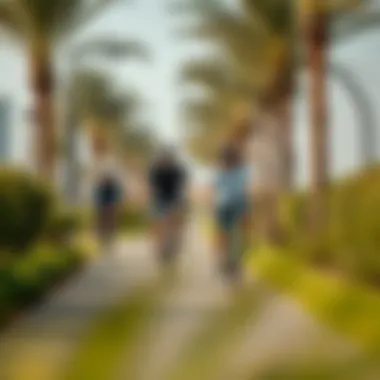Discovering Dubai's Dynamic Cycling Trails


Intro
In the bustling metropolis of Dubai, where the skyscrapers touch the clouds and the desert dances in the ever-shifting sands, an increasingly popular facet of urban culture is taking the city by storm—the cycling tracks. The city may be known for its luxurious lifestyle and extravagant shopping experiences, but it’s also carving a niche for itself in the realm of cycling. The rise of these cycling infrastructures speaks to a broader trend toward sustainability and healthy living, while also enhancing the commuting experience for its residents.
Whether it’s the thrill of pedaling down long stretches of smooth, designed pathways or the subtle joy of integrating fitness into daily transit, cycling in Dubai has evolved significantly over recent years. This article aims to navigate through various cycling tracks in Dubai, shedding light on their design, accessibility, and the multifaceted roles they play in both leisure and transportation for the growing population.
In the words of local cyclists, “Life is like riding a bicycle. To keep your balance, you must keep moving.” In this spirit, we examine key locations, unique features, and the overall experience of cycling in this dynamic city. As we delve into the analysis of cycling trends, cultural impacts, and community initiatives, we’ll unwrap the layers that make cycling an appealing option in this rapidly changing landscape.
Consider this a dual exploration—one that kites along the windy paths meant for fun, and another that tackles the serious business of commuting. The traffic jams have no room for us, and cyclists are singing their anthem of freedom on these well-planned tracks. Join us as we embark on a journey through the cycling tracks of Dubai, appealing both to the adventurous soul and the meticulous planner alike.
Prolusion to Cycling in Dubai
Cycling in Dubai is not merely a pastime or a fitness trend; it has burgeoned into a vital part of the city’s transport infrastructure and lifestyle. In a rapidly modernizing urban landscape, the significance of sustainable mobility solutions becomes ever more pronounced. This article aims to delve into the nuances of cycling within the city context, discussing various dimensions such as accessibility, community involvement, and the reconciliation of cycling with the demands of urban commuting.
A Growing Trend
In the heart of the desert, where temperatures can soar and the sun beats down with an intensity that can make the pavement shimmer, you might not think cycling would flourish. Yet, over recent years, Dubai has witnessed a remarkable surge in cycling aficionados. This upswing isn’t coincidental; it’s a ripple effect of urban development initiatives and a growing desire for healthier living.
More parks, cycling tracks, and community awareness about fitness are fostering a culture where cycling is embraced not just as recreation, but as a practical means to navigate the city. Outdoor events like the annual Dubai Cycling Challenge showcase this shift, where families, enthusiasts, and competitive cyclists all come together. One could argue that cycling is evolving from a mere sport into a cherished way of life for many residents.
Moreover, the visibility of cyclists on roads has sparked discussions about cycling’s popularity, evident when folks notice more riders cruising through Jumeirah or Al Qudra. The infusion of local cycling clubs and social media groups dedicated to cycling expeditions has created a palpable buzz.
The Role of Cycling in Urban Mobility
As cities become increasingly congested, the need for alternative transport methods becomes paramount. Cycling emerges as a pragmatic option, offering a solution to those tired of being stuck in bumper-to-bumper traffic. With urban planners placing greater emphasis on green initiatives, cycling is being integrated into the overall framework of city transport.
Every ride along a dedicated cycle path contributes not only to personal well-being but also to a larger vision of reduced carbon emissions. It reshapes the urban landscape, encouraging a shift in mindset that regards cycling as an integral component of commuting.
Cycling can effectively bridge the gap between public transportation hubs and one’s final destination. When strategically placed bike lanes and rental services come into play, residents discover the city in a manner that is both engaging and environmentally friendly. The narrative of cycling in Dubai is one of growth across various strata, uniting fitness enthusiasts, advocates of sustainable transport, and everyday commuters alike.
"Investing in cycling infrastructure not only boosts the local economy but also enriches community health and cohesion."
As we continue to unravel the layers of cycling in Dubai, it becomes clear that this trend is not a fleeting whim, but rather a foundational shift that could redefine how Dubaians move about their lives.
Overview of Cycling Tracks
Cycling, once a leisure activity for many, is assuming a pivotal role in urban mobility, particularly in cities like Dubai. As the city expands, understanding the landscape of cycling tracks becomes key for residents and visitors looking to navigate this vibrant metropolis more sustainably. This overview aims to break down the types and designs of these tracks, outlining their significance and suitability for different users.
Types of Cycling Tracks
Dedicated Trails
Dedicated cycling trails stand as the crown jewels of urban cycling infrastructure. These tracks are exclusively designed for cyclists, free from the interruptions of vehicular traffic. Their major advantage lies in the peace of mind they offer cyclists, leading to a pleasurable riding experience.
One notable characteristic of dedicated trails in Dubai is their scenic routes, often weaving through parks or along waterfronts, making them not just a means of transport but also a recreational haven. Cycling on these paths encourages a sense of community among riders while boosting physical health through consistent exercise.
Nevertheless, while they offer significant advantages, dedicated trails can face challenges. Some may be located far from central hubs, requiring additional planning to integrate them into everyday commuting. Additionally, during peak hours, they may become crowded, which can detract from the serene experience they aim to provide.
Mixed Traffic Routes
On the flip side, mixed traffic routes combine cycling pathways with regular roads. This type of route mirrors the reality of urban travel, where cyclists must navigate through cars and buses. It’s a practical approach for integrating cycling into the broader transportation network, ensuring that biking is a viable option for commuters.
A defining trait of mixed traffic routes is accessibility; they are often found in areas not feasible for dedicated lanes. However, mixing cyclists with motor vehicles raises safety concerns. Cyclists may feel more vulnerable, especially in areas with heavy traffic. Nevertheless, many cities are addressing these issues with better signage and driver awareness programs to enhance safety on these shared routes.
Bike Lanes
Bike lanes represent a middle ground—designated spaces within roadways exclusively for cyclists, demarcated by painted lines or physical barriers. They offer some protection while still integrating within the existing road structure. Bike lanes can significantly benefit those looking to incorporate cycling into their daily routines without needing extensive journey planning.
Their unique feature is their flexibility in accommodating cyclists alongside motor vehicles, allowing seamless transitions in urban environments. However, inconsistencies in design can create issues. Not all bike lanes are equally well-maintained or safe, particularly if obstructed by parked cars or debris, which can create hazards for cyclists.
Track Design and Construction
Safety Features
Safety features are crucial components in designing cycling tracks. These elements encompass everything from signage to physical barriers separating cyclists from vehicular traffic. Effective safety measures can minimize accidents and promote cyclist confidence.
Key characteristics include dedicated signage informing both cyclists and drivers of merging routes or potential hazard zones. Reflective surfaces can also play a role, enhancing visibility at night.
However, not every safety feature is foolproof. High-traffic areas can still pose risks, particularly if drivers aren’t educated about sharing the road effectively. Thus, continuous public awareness and education campaigns are vital for fostering a safer environment for all users.
Surface Materials
The selection of surface materials for cycling tracks significantly influences the cycling experience. Smooth surfaces, such as asphalt or concrete, provide comfortable and efficient rides as they require less effort to navigate.
The key characteristic here is durability; materials must withstand Dubai's climatic challenges, including extreme heat and occasional sandstorms. Improperly chosen materials may deteriorate quickly, necessitating costly repairs.
While most surfaces are relatively low maintenance, any flaws like cracks or potholes should be taken seriously, as they could lead to injuries. Regular inspections and maintenance are essential to uphold the safety and quality of cycling tracks.


Lighting and Visibility
The integration of adequate lighting and visibility features in cycling tracks sends a powerful message regarding their importance. Notably, these elements contribute to rider safety during the cooler evening hours when many cyclists still prefer to ride.
The unique characteristic of well-lit tracks ensures that cyclists can detect potential hazards well in advance. Smart lighting solutions, including motion-activated lights, can further enhance visibility and awareness, promoting safer travel.
Yet, inconsistent lighting can lead to dangerous situations. Many cyclists still find poorly lit areas daunting, deterring them from nighttime rides. Therefore, development plans should prioritize consistent lighting throughout all cycling routes.
Featured Cycling Tracks
Featured cycling tracks make a significant impression in the landscape of Dubai, not only enhancing the cycling experience but also integrating seamlessly into the urban fabric. These routes are essential for recreational cycling enthusiasts and daily commuters alike, offering an array of options that cater to diverse needs and preferences. Exploring these tracks reveals their unique characteristics, benefits, and considerations, reinforcing the importance of cycling culture in the rapidly modernizing city.
Al Qudra Cycling Track
Length and Terrain
Al Qudra Cycling Track stretches around 86 kilometers, making it one of the longest cycling paths in Dubai. The track’s length offers cyclists a sense of freedom, allowing for long rides away from congested urban spaces. The terrain is mostly flat with occasional gentle slopes, which is friendly for all levels of cyclists ranging from beginners to seasoned riders. This characteristic contributes to its popularity, as cyclists can comfortably ride for varying distances, whether for leisure or training.
In terms of nature, the track coursess through the desert landscape, offering views of undisturbed natural beauty and wildlife. One unique aspect of this terrain is its ability to bring cyclists closer to the serene environment, providing a sort of peaceful escape from the buzzing city life. However, the sandy edges might not cater well to all cyclists, especially those unaccustomed to such settings, making it a mixed bag for users seeking different experiences.
User Experience
User experience on Al Qudra is generally favorable, characterized by a well-maintained track that provides a pleasant ride. Cyclists enjoy the absence of heavy traffic, creating a safe environment where one can connect with the rhythm of cycling. A key highlight is the camaraderie among cyclists, often sharing tips and experiences along the way, fostering a community vibe.
Nonetheless, some challenges exist. For instance, the remoteness of the track means that services are limited. This could potentially detract from the overall enjoyment for those unused to long-distance cycling without easy access to rest stops or facilities.
Amenities
Al Qudra Cycling Track is equipped with several amenities that enhance the cycling experience. Rest stops, refreshment stations, and bike repair services are available, helping ensure cyclists have everything needed for a successful outing. Informational signage along the track promotes not only safety but also awareness of local wildlife, enriching the overall experience.
However, there’s room for improvement. While certain amenities are available, the locations are sparsely distributed, which might be a challenge for those planning longer rides without adequate preparation. This aspect underscores the importance of knowing one’s own limits and planning adequately before embarking on the extended journey.
Dubai Marina Cycle Track
Scenic Views
The Dubai Marina Cycle Track offers some of the most breathtaking views in the city. Stretching along the waterfront, it provides cyclists with an unparalleled perspective of the marina’s stunning skyline. This picturesque route not only pleases the eye but also acts as an incentive for people to cycle more often. Enjoying scenery while cycling can enhance one’s overall journey, making it more enjoyable and relaxing.
However, the proximity to residential areas and high traffic spots can lead to interruptions, especially during peak hours where foot and vehicular traffic increase. Such factors can occasionally detract from the scenic delights, causing distractions or disruptions.
Accessibility
Accessibility is a critical feature of the Dubai Marina Cycle Track. The track is designed to be easily reachable from numerous points, making it convenient for both locals and tourists. Public transport options nearby include metro and bus services, ensuring that cyclists do not face difficulties getting to the starting point.
However, as the area becomes increasingly popular, the influx of visitors can create overcrowded situations, particularly during weekends. This can lead to some logistical challenges for cyclists aiming to maintain a steady pace without interruptions.
Safety Measures
Safety measures on the Dubai Marina Cycle Track have improved over the years with dedicated bike lanes and clear signage. Well-lit paths help ensure visibility in the evenings. The presence of trained personnel for emergencies adds an extra layer of security.
Despite these advancements, cyclists should remain cautious. Crossings and interactions with pedestrian traffic require vigilance and awareness. The balancing act between safety protocols and actual rider behavior can be tricky, and one could argue that a constant improvement in infrastructure would further enhance the overall safety of the track.
Jumeirah Corniche
Cultural Significance
The Jumeirah Corniche holds cultural significance in Dubai, acting not just as a cycling track but as a social hub. It reflects the city’s commitment to promoting outdoor activities and community involvement. Here, cycling becomes a way for individuals to engage with both the local culture and scenic coastal landscapes.
This blend of culture and outdoor activity has made the Corniche a favored spot for various community events and themed rides, offering a unique cycling experience that comes with a sense of belonging. This cultural vibrancy enriches the overall cycling experience, but over tourism during peak seasons poses the risk of diminishing the very same cultural elements it seeks to promote.
Community Engagement
Jumeirah Corniche facilitates significant community engagement through hosted events that invite local families and cyclists. Regular cycling groups build connections, making the Corniche a gathering space where friendships form and shared experiences thrive. This fosters a sense of belonging and camaraderie among diverse groups.
However, on the downside, increased gatherings can lead to occasional congestion, making it less optimal for those seeking a peaceful cycling experience. Striking a balance between community activities and maintaining a cycling-friendly atmosphere could be crucial moving forward.
Events and Activities
The track is a hotspot for events and activities, from cycling competitions to fitness challenges, drawing participants from all over. These gatherings not only showcase local talent but also encourage more individuals to take up cycling, raising awareness about health and fitness.
Yet, event frequency may lead to temporary restrictions on track access. Regular users should be informed in advance to avoid inconvenience. This highlights the ongoing need for communication to keep the cycling community engaged and informed about upcoming lar events.
The Benefits of Cycling
Cycling holds multitude advantages, not just for the individual but also for the community and environment. In a vibrant city like Dubai, where life speeds along with the rapid pace of development, cycling emerges as a versatile solution that embraces health, sustainability, and economic growth. Understanding these benefits provides insight into why cycling is gaining traction among residents and visitors. Let's take a closer look at the specific aspects that make cycling a beneficial activity in Dubai.
Health and Fitness


Cycling is not merely a mode of transportation; it's a dynamic workout that seeds positive changes in one’s health and fitness levels. Engaging regularly in cycling activities promotes cardiovascular health, aids weight management, and builds muscle strength. The beauty of riding a bike is that it doesn’t feel like traditional exercise. Pedaling through scenic paths like those found in Al Qudra can feel like leisure rather than sweat breaking labor.
Additionally, with many parks and calm roadways, it's easy to incorporate cycling into one's daily routine without making it seem like a chore. Research indicates that even short cycling commutes can have profound effects on overall well-being, reducing stress and enhancing mood. Cycling can contribute to better mental health, combatting anxiety and depression. It is well worth considering that in the rush of Dubai's urban landscape, carving out a space for a bit of cycling can lead to rejuvenation.
Environmental Impact
In terms of environmental consciousness, the benefits of cycling are hard to overlook. With the city’s vision towards sustainability growing stronger, cycling contributes to reducing carbon footprints significantly. By choosing to cycle instead of driving, individuals directly decrease their reliance on fossil fuels.
- Reduction of Emissions: Fewer cars on the roads mean lower air pollution levels.
- Decreased Traffic: Cycle tracks help alleviate congestion, allowing smoother transit for everyone.
- Promoting Green Spaces: Widespread cycling can lead to the demand for more bike-friendly areas and green zones.
Dubai aims for a greener future, and embracing cycling is a step toward reaching that goal. It aligns perfectly with the initiatives set by local authorities to promote sustainable living. The air quality benefits are crucial in a city famous for its hot summers and pollution from traffic.
Economic Advantages
The economic impact of cycling cannot be dismissed either. Local businesses see benefits when cycling becomes common. Here are some reasons why:
- Boosting Local Economies: Increased cycling can translate into higher foot traffic for local shops and cafes, especially those located near cycle tracks.
- Job Creation: As the demand for cycling infrastructure grows, so does the need for maintenance, bike rentals, and repair shops.
- Reducing Infrastructure Costs: Cycling can significantly lower the pressure on public transport systems and reduce the need for extensive road infrastructure, leading to savings for city budgets.
Investing in cycling infrastructure pays dividends far beyond just physical tracks. Improvements in cycling can enhance property values and nurture a vibrant, interconnected community. In this ever-evolving metropolis, the economic narrative is indeed intertwined with the cycling revolution.
Overall, the benefits of cycling create a compelling case for its increase in popularity. As more residents embrace this mode of transport, they contribute to a healthier lifestyle, a cleaner environment, and a stronger economy. Imagine seeing rows of cyclists on the streets of Dubai—this is not just a dream; it is a future that can be shaped through awareness and initiative.
"Cycling is the perfect solution for a healthy life and a healthy planet."
There’s no denying the potential impact cycling has, which is why fostering a cycling culture is essential for the holistic growth of Dubai.
Challenges Facing Cyclists
Cycling in Dubai is on an upward trend, but it doesn't come without its hurdles. As the number of cyclists increases, so do the challenges they face. Addressing these issues is vital to creating a safer and more enjoyable experience for both recreational riders and commuters. Whether it's the busy streets, the infrastructure that needs improvement, or the harsh climate, understanding these challenges is essential for the development of a robust cycling culture in the city.
Traffic Safety
One of the most pressing concerns for cyclists in Dubai is traffic safety. The city’s rapid expansion, characterized by a high volume of vehicles, renders cycling intersections particularly hazardous. It’s like navigating a minefield; one wrong move can lead to dire consequences. Cyclists must often share the road with cars that sometimes tend to disregard the presence of two-wheeled riders.
- Vehicle Behavior: Many drivers may not be accustomed to seeing cyclists on the road, which can lead to potential friction. This lack of awareness can result in aggressive driving patterns and less space given to cyclists.
- Safety Initiatives: In recent times, there have been multiple efforts to enhance traffic laws and implement safety campaigns aimed at raising awareness among drivers about the rights of cyclists.
“Safety is not just a priority, but a shared responsibility between cyclists and drivers.”
Without proper education and infrastructure improvements, cyclists might find themselves at risk.
Infrastructure Limitations
Despite a commendable effort in developing cycling paths, significant gaps remain in Dubai’s infrastructure. Imagine trying to piece together a puzzle where several crucial pieces are missing; this is what cyclists contend with on a daily basis.
- Segregated Cycling Paths: While some dedicated tracks exist, they are often not connected effectively, forcing cyclists to navigate through mixed traffic, which can be perilous.
- Bike Parking Facilities: Another concern is the lack of secure bike parking, which can deter potential cyclists. Having a reliable area to leave your bike can transform the cycling experience, encouraging more people to ditch their cars.
The local government has made strides in addressing these issues, but much more work needs to be done to create a seamless experience for cyclists.
Weather Conditions
The weather in Dubai can pose a serious challenge to cyclists, especially during the scorching summer months. The heat can be oppressive, making it uncomfortable and even dangerous to ride for extended periods.
- Heat and Hydration: Cyclists must be mindful of hydration and heat exhaustion. Riding under the blazing sun without taking necessary precautions can lead to health issues. Some cyclists have shared that biking in the early hours of the morning or late afternoons is much more bearable, as the temperatures tend to drop slightly.
- Rainy Days: It's ironic, but when it rains, the conditions can quickly change for the worse. The streets can become slippery and visibility drops, making it a treacherous endeavor for cyclists. The brief rainy season is yet another factor that might discourage riders from getting on their bikes.
Navigating these climate-related challenges necessitates preparedness and awareness to ensure safety and enjoyment while cycling in Dubai.
Government Initiatives to Promote Cycling
Cycling is steadily weaving itself into the fabric of Dubai, thanks in part to various government initiatives aimed at fostering this new lifestyle. The rise in cycling convenience and popularity reflects the authorities' commitment to transforming the city into a more bicycle-friendly environment. These programs play a pivotal role in ensuring not just infrastructure enhancements but also community engagement, catering to both seasoned cyclists and newcomers eager to hit the tracks.
Investment in Infrastructure
To truly lay down the wheels for cyclists, investment in infrastructure is vital. In Dubai, the government has poured significant resources into creating an extensive network of cycling tracks, some of which stretch for dozens of kilometers across scenic routes. This proactive approach addresses the double-edged sword of safety and accessibility.
- Dedicated Cycling Paths: These exclusive trails prioritize safety and ease, allowing cyclists to navigate without the risk posed by cars or pedestrians. The Al Qudra Cycling Track is a prime example of this foresight, equipped with bike lanes that foster a smoother ride.
- Repair Facilities: Alongside these paths, maintenance stations are becoming common, providing cyclists quick access to repairs and air for tires, reinforcing the notion that cycling in Dubai can be as simple as hopping on your bike.
- Connecting Transportation: Investment also includes ensuring cycling tracks connect with public transport, making it easier for commuters who prefer a mixed-mode of travel. The objective here is to make it seamless for individuals to transition between cycling and using the metro or bus services.
Public Awareness Campaigns
Even the best infrastructure needs a push from public awareness campaigns to activate community engagement. The Dubai government has launched initiatives focused on educating residents about the benefits of cycling, with various forms of media graphics, social platforms, and local events playing a role.
- Cycling Safety Workshops: Workshops inform cyclists about rules, safe riding practices, and how to maintain their bikes. This educational outreach helps mitigate risks associated with new cyclists who may not be aware of the road's dos and don'ts.
- Incentives for Cyclists: Some campaigns provide incentives for cycling to work, encouraging people to leave their cars at home. Initiatives like these can turn an uphill battle into a stroll in the park, allowing citizens to save on fuel while contributing positively to air quality.
- Engaging Visual Media: Campaigns often utilize compelling visuals and relatable anecdotes, targeting both experienced and novice riders. By doing so, the government can foster a more welcoming atmosphere around cycling as a daily activity, rather than just a weekend hobby.
Community Programs
Community programs are the glue that holds all these initiatives together. They not only raise awareness but also create a sense of belonging among cyclists.
- Local Cycling Clubs: These clubs bring together cyclists from diverse backgrounds, organizing regular meet-ups and group rides, making it easier for people to connect over a shared passion.
- Events and Competitions: The government also sponsors events such as cycling races or festivals, which serve as platforms for showcasing cycling culture and encouraging participation from the general public, adding a competitive edge that can make cycling more appealing.
- Collaborations with Schools: Involving schools in cycling initiatives helps nurture a generational shift in attitude towards cycling. Training sessions for children not only promote safe riding but also instill the benefits of cycling from a young age.


"Investing in cycling infrastructure is an investment in a sustainable future. As we create spaces for cyclists, we're fostering a healthier community and a cleaner environment."
Through consistent government initiatives, including infrastructure investment, public awareness campaigns, and community programs, Dubai demonstrates a robust commitment toward embracing cycling as not just a means of transport but as a lifestyle choice.
Cycling Communities and Culture
The essence of cycling in Dubai stretches far beyond the mere act of riding a bike. It embodies a vibrant community spirit, transforming the way residents and expats interact with one another and their environment. The significance of cycling communities and culture within this bustling metropolis cannot be overstated, as it fosters inclusivity, encourages wellness, and promotes a lifestyle intertwined with both leisure and transportation.
Local Cycling Clubs
Local cycling clubs play an essential role in nurturing the cycling culture in Dubai. These social hubs provide riders of all levels with opportunities to meet, ride together, and share experiences. For instance, clubs like the Dubai Roadsters and the Cycle Hub are notable for their welcoming atmosphere and structured training sessions. They create a sense of belonging for members, whether they are seasoned cyclists or newcomers just starting.
Participating in these clubs presents various benefits:
- Skill Development: Members can learn from experienced cyclists by attending workshops and group rides, significantly enhancing their riding techniques.
- Networking Opportunities: Clubs foster relationships that evolve into friendships, making it easier for riders to find partners for leisurely rides or serious training.
- Community Engagement: Many clubs organize events that contribute to local charities, allowing cyclists to give back while promoting their passion for biking.
Cycling Events and Competitions
The cycling scene in Dubai is electrifying, with numerous events and competitions held throughout the year. These gatherings not only showcase the growing interest in cycling but also encourage competition and camaraderie among participants. Events like the Dubai Tour and the Ride for the Kids charity ride attract both local and international cyclists, providing a platform for showcasing skills and talents.
Participation in these events yields a wide array of experiences:
- Competition: For those looking to challenge themselves, races allow riders to push their limits and test their endurance against fellow cyclists.
- Community Bonding: Events foster a sense of unity among participants, strengthening the fabric of the cycling community as riders cheer for one another.
- Visibility: High-profile events raise awareness about the importance of cycling, encouraging more individuals to consider biking as a viable mode of transportation.
Social Media Influence
In modern times, social media has become a powerful tool in shaping cycling culture. Platforms like Instagram and Facebook have created spaces where cyclists can share their experiences, tips, and stunning visuals of their rides. These platforms serve as an inspiration for aspiring cyclists and allow seasoned riders to connect with a broader audience.
Through social media, various aspects come to light:
- Sharing Experiences: Videos and photos from rides showcase the beauty of Dubai's cycling routes, making them more enticing for potential riders.
- Building Community: Online groups on Facebook or forums like Reddit offer a platform for cyclists to share advice, arrange meet-ups, or even find riding partners.
- Advocacy: Engaging posts can spotlight necessary improvements to cycling infrastructure, drawing public attention to the needs of cyclists and fostering discussions about urban mobility.
"Cycling in Dubai is more than a leisure activity; it's a movement that binds us together, paving the way for a healthier and more interconnected community."
Future of Cycling Tracks in Dubai
As Dubai continues to evolve, so too does its commitment to providing world-class cycling tracks that encourage both leisure and sustainable commuting. The future of cycling tracks in this bustling city holds significant relevance, not just for avid cyclists but for anyone invested in urban living and environmental responsibility. With a focus on upcoming projects, recent technological innovations, and integration with broader transportation networks, the next steps in cycling infrastructure will greatly influence both the lifestyle of residents and the city's ecological footprint.
Upcoming Projects
The horizon is bright with ambitious plans for new cycling infrastructure. Among the proposed developments, these projects stand out:
- Expansion of Existing Tracks: Longer and more interconnected routes are planned to increase accessibility.
- New Dedicated Trails: Plans for additional separate cycling lanes are on the table, notably in high-density areas to promote cycling as a primary mode of travel.
- Bike Share Programs: To ease mobility for residents and tourists alike, schemes will include additional bike rental stations strategically placed throughout the city.
These developments are designed to not just enhance cycling experiences but also to cater for the quickly growing cycling community, encouraging both fitness and environmentally-friendly transportation options.
Innovative Technologies in Cycling
Technology is set to revolutionize the cycling experience in Dubai.
One exciting innovation is the smart bike. These are equipped with GPS tracking and sensors that provide real-time data on traffic conditions and air quality. Moreover, there are discussions around incorporating artificial intelligence and machine learning to improve routing systems, allowing cyclists to select the safest and most efficient paths available.
Additionally, the integration of app-based platforms for cyclists can facilitate organized community rides, offer guidance on routes, and promote safer cycling habits through educational tools. This infusion of technology not only creates a more user-friendly cycling landscape but can also foster a sense of community among cyclists.
Integration with Transportation Networks
A seamless integration of cycling tracks with public transportation systems is crucial for the future mobility of Dubai's residents.
- Multi-Modal Transport: Future plans aim to connect cycling tracks directly to metro stations and bus stops. This kind of access will encourage cyclists to use their bikes for part of their journey, reducing reliance on cars and easing congestion in the city.
- Safe Parking Solutions: Secure bike parking facilities at major transit hubs will make it easier for cyclists to transition between cycling and public transport.
"A well-connected cycling network can significantly reduce traffic congestion and improve the urban environment."
This emphasis on connectivity transforms cycling from just a recreational activity into a bona fide commuting option.
Through a strategic blend of future projects, advanced technology, and transportation integration, Dubai is on a trajectory to enhance its cycling environment. These initiatives promise not only to improve the daily life for cyclists but also contribute positively to the city’s urban landscape and sustainability goals.
Culmination
When cycling through the wonders of Dubai, the narrative extends beyond the mere act of riding a bike. It embodies a vibrant tapestry of community, culture, and innovation. As this article nears its finish, it becomes clear just how pivotal cycling tracks have become in shaping the urban experience here. Cycling is not just a leisure pursuit; it’s evolving as a practical mode of transportation that complements Dubai’s expansive infrastructure.
Reflecting on the Cycling Experience in Dubai
The cycling experience in Dubai is distinctively tailored to enhance the lives of its residents and visitors. From the gentle winds of the Al Qudra track to the bustling energy of Dubai Marina, every route offers something unique. Cyclists often remark on the sense of freedom that comes with gliding along these diverse paths. There’s a shared camaraderie among cyclists, each journey fostering connections, whether through a casual nod or an enthusiastic wave.
Further, the accessibility and convenience of these tracks make cycling a practical option for many. With designated lanes and clearly marked paths, riders navigate the city with ease, fostering a sense of safety that’s vital for encouraging more people to ditch their cars.
Moreover, the aesthetic appeal of cycling in locations like Jumeirah Corniche highlights not just the landscapes, but also the culture. Cyclists often find themselves pausing, simply to soak in the magnificent views of the Burj Al Arab, intermingling leisure with tourism in a way that few other activities can offer.
In summary, as we reflect on the cycling experience in Dubai, it’s apparent that these paths are more than just routes; they are vital arteries pumping life into the urban scene.
"Cycling in Dubai isn't just a ride; it's a journey of discovery."
Overall, the ongoing development of cycling tracks in Dubai underscores a commitment to sustainability and health. With each pedal stroke, riders contribute to a greener future while embracing a lifestyle that celebrates physical activity and community engagement.
As we look forward, the future of these cycling tracks shines brightly, promising a closer-knit city, where the pulse of cycling continues to resonate through the hearts of its people.







